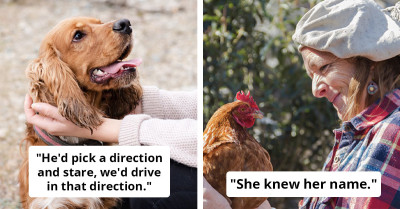Couple Installs Privacy Fence To Protect Their Large Dogs From Neighbor's Children Who Used To Taunt Them Whenever They Were In The Backyard
Any hope for friendship with their neighbor went down the drain when a couple installed a fence between their properties. The OP, her husband, and their two dogs have lived in their house for five years.
Their new neighbors moved in more than a year ago. The two kids, under the age of five, formed a habit of bothering OP's dogs whenever they were out in the backyard.
The kids ran out of their house whenever they saw the dogs in the backyard. They would go to the chain-link fence to bang on it and yell at OP's dogs.
Her large dogs used to love lazing about in their backyard for hours. Since the family moved in, the dogs have become increasingly hesitant to even go out to do their business.
The parents didn't see a problem with their children's taunts toward the dogs. OP saw the mom watching her kids through their window, but she never intervened.
OP talked to the kids and gently told them that they scared her dogs. She also went over to talk to the parents, who dismissed her concerns or made a non-committal response that they would talk to their children.
OP was done tolerating their neighbor's intrusion. She and her husband applied for a permit to install a new fence and were successfully placed on the waitlist.
OP and her husband jumped at the opportunity when they were informed they were next in line for the fence installation.

They brought their dogs to her sister's farm, where they ran to their hearts' content.

OP didn't inform her neighbors about the fence. The construction was inside their property, and access from the neighbor's side of the fence wasn't necessary.

Understanding Behavioral Responses
In situations where pets are involved, emotional reactions can be intense. Research in animal behavior and human-animal bonding illustrates how pets often become integral parts of our family structures. The distress caused when children taunt dogs can evoke protective instincts in owners, leading them to take measures to safeguard their pets’ well-being.
This response highlights the deep emotional connections people have with their animals, which can significantly influence their decision-making.
When they got home, the mom stormed over to their house. She said her kids were inconsolable since the fence was put up. They were heartbroken that they could no longer see "their dogs."
OP explained to her neighbor that she had tried to approach their issue amicably multiple times. The mom yelled insults at OP until she had no choice but to shut the door in her face.

The least she could have done was talk to OP about her children approaching OP's dogs.

It would have been the neighborly thing to do. OP said she wouldn't have let her dogs near the kids because they were too little to be friends with her large livestock guardian dogs.

When considering the installation of a privacy fence, it's essential to understand the social dynamics at play. According to social psychology, individuals often react strongly to perceived threats to their loved ones, including pets. This protective behavior can be seen as a natural instinct, rooted in the desire to create a safe environment for those we care about.
Understanding these underlying motivations can help in discussing the decision with neighbors in a more empathetic manner.
OP's dogs were actually more well-behaved than the children in this story.

The parents haven't taught their kids how to treat animals. No pets should be subjected to that household.

OP's dogs are back to their old, outdoorsy selves and are too busy marking their new fence to worry about petty human drama.

The Role of Communication
Effective communication is key to preventing misunderstandings in neighborhood dynamics. Research indicates that open dialogue can help de-escalate potential conflicts and foster a sense of community. By explaining the reasons for installing a fence and addressing any concerns neighbors may have, individuals can facilitate a more positive interaction.
Engaging in a friendly conversation about the benefits of the fence for both pets and children can promote understanding and cooperation.
It was becoming a safety issue. The new fence was the best solution since the neighbors didn't even attempt to teach their children how to treat animals.

OP and her husband aren't to be blamed for the situation.

Now, they just need to make sure that their neighbor doesn't try to harm her dogs more than they already have.

Establishing boundaries when it comes to pets can also lead to healthier interactions with neighbors. According to studies on interpersonal relationships, clearly defined boundaries help create a sense of safety and respect in community dynamics. By discussing how the fence will enhance the safety of both pets and children, individuals can frame the conversation in a way that emphasizes mutual benefits.
Such an approach can reduce friction and foster a positive neighborhood atmosphere.
Neighborly disputes are nothing new. OP and her husband tried the gentle approach of civilly discussing the issue with their neighbors, but it didn't work.
The fence was the best option for everyone. It could be true that the children were heartbroken over losing the limited access they had to OP's dogs, but what they used to do was too dangerous for it to be allowed to continue.
Empathy and Understanding
Empathy plays a crucial role in navigating these types of situations. Research from emotional intelligence studies indicates that understanding another person's perspective can lead to more constructive outcomes. By recognizing that the children’s behavior may stem from curiosity rather than malice, pet owners can approach the situation with greater compassion.
This empathetic stance can help in resolving conflicts and maintaining harmonious relationships within the neighborhood.
Psychological Analysis
This situation illustrates the complexities of protecting beloved pets while maintaining good neighborly relations. The instinct to shield animals from perceived threats is deeply ingrained, and it’s essential to approach these scenarios with empathy and clear communication. By fostering understanding and mutual respect, pet owners can navigate these challenges more effectively.
Analysis generated by AI
Analysis & Alternative Approaches
Navigating neighborhood dynamics, especially when pets are involved, requires a blend of empathy, communication, and boundary-setting. Understanding the emotional bonds between humans and animals can inform decisions that promote safety and harmony. Research emphasizes that fostering open dialogues can lead to more cooperative relationships within communities, benefiting all parties involved.



